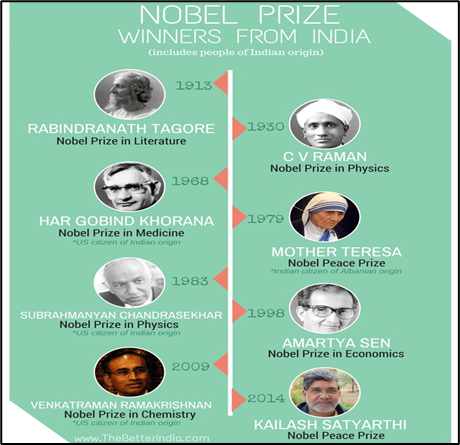Why in News?
The Nobel Prize season highlights a stark reality: since its inception in 1901, only 12 individuals of Indian origin have been awarded the Prize, with just five being Indian citizens.
Notably, Dr. C.V. Raman stands out as the only Indian laureate in the science category, receiving the Nobel in Physics in 1930 for the discovery of the Raman Effect.
The 94-year gap since this achievement raises concerns about India's scientific recognition on the global stage.
What’s in Today’s Article?
- India's Nobel Prize Journey
- Reasons Behind India’s Poor Performance in the Nobel Prize Science Category
- Strategies to Enhance India’s Scientific Landscape
India's Nobel Prize Journey:

- Abhijit Vinayak Banerjee - an Indian-born American economist, was awarded (along with Esther Duflo and Michael Kremer) 2019 Nobel Prize for Economics for helping to develop an innovative experimental approach to alleviating global poverty.
Reasons Behind India’s Poor Performance in the Nobel Prize Science Category:
- Limitations in research:
- Inadequate basic research: There is insufficient focus on fundamental research, hindering innovation.
- Low public funding: Public funding for R&D in India is ~0.7% of its GDP, which is significantly lower than countries like the US (which spends ~3% of its GDP on R&D), and even behind other BRICS nations.
- Excessive bureaucracy: A bureaucratic framework stifles creativity and slows down the research process.
- Decay of university research capabilities: Many universities struggle to maintain research standards, further limiting potential breakthroughs.
- Diminished pool of researchers: India has approximately five times fewer researchers per capita compared to the global average, significantly reducing its chances of producing Nobel-worthy candidates.
- Selection process is highly selective:
- While India has produced several notable scientists who were nominated for Nobel Prizes, many have been overlooked.
- Among the publicly disclosed nominations, six Indian scientists stand out: Meghnad Saha, Homi Bhabha, SN Bose (Physics), GN Ramachandran, T Seshadri (Chemistry), and Upendranath Brahmachari (Medicine).
- All were nominated multiple times, yet none secured the award.
- Several prominent scientists have been overlooked entirely. For example, Jagadish Chandra Bose (who pioneered wireless communication) and KS Krishnan (a co-discoverer of the Raman scattering effect).
- Western dominance:
- The overwhelming majority of Nobel Prizes in sciences have been awarded to researchers from the US and Europe.
- Out of the 1,100+ laureates in these categories, a mere handful hail from Asia, Africa, or South America, with Japan leading the non-Western countries.
Strategies to Enhance India’s Scientific Landscape:
- Emphasise upon STEM education:
- To foster groundbreaking research, India must redirect its focus from the current engineering rush to fundamental scientific education.
- Early identification and nurturing of talent through scholarships and mentorship can cultivate gifted minds.
- Reviving initiatives like the Kishore Vaigyanik Protsahan Yojana (KVPY) will encourage students to pursue careers in pure sciences, supporting long-term scientific innovation.
- Address brain drain:
- India's scientific community remains relatively small, with only 260 scientists per million people compared to over 4,000 in the US and UK.
- Indian-origin scientists, such as Hargovind Khorana, Subrahmanyan Chandrasekhar, and Venkatraman Ramakrishnan, received Nobel prizes in their respective fields.
- However, they conducted their groundbreaking work abroad and were not Indian citizens at the time of their awards.
- To retain talent and prevent brain drain, India must improve infrastructure, salaries, and career prospects.
- Bolster research capabilities:
- For the next generation of Nobel laureates to be produced, systemic support is just as important as individual genius.
- Therefore, increased investment (both public and private) in scientific research and infrastructure, and creating a supportive ecosystem for innovative research, are crucial for fostering Nobel-worthy discoveries.
- Foster international collaborations:
- Many Nobel-winning discoveries arise from interdisciplinary and international collaborations.
- India should promote global partnerships by encouraging young scientists to intern with top research groups worldwide.
- Initiatives like a "1000 Scholar Programme" could facilitate knowledge exchange and innovation.
- Cultivate a culture of risk-taking:
- A significant barrier to Nobel-level research in India is the reluctance to pursue high-risk, innovative projects.
- Reducing bureaucratic constraints and promoting a culture of bold experimentation is vital for unlocking transformative discoveries.










